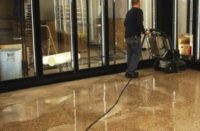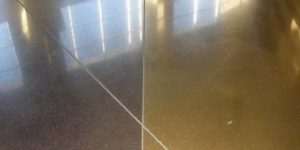You’ve heard of densifiers. But let’s face it — much of what you’ve heard about them to date has come from densifier manufacturers.
The following suggestions and observations on the use of densifiers in concrete polishing come from contractors with considerable expertise in the industry.
Learn how to recognize rejection. Identifying when the densifier has been applied to the point of rejection is an important challenge, says Roy Bowman, a member of the Concrete Polishing Association of America board of directors and owner of Concrete Visions Inc., Tulsa, Okla. “Typically you will see it on the surface and not being readily or fully absorbed. Then you know you’ve got enough. Manufacturers’ literature may not state this.”
Don’t obsess about cost. Bowman and other contractors drive home the point that the densifier represents a relatively low-cost component in the context of the job as a whole.
“It’s pennies per square foot to do it right,” Bowman says. “The cost to take care of something done wrong is a whole lot more. It doesn’t matter which densifier you use. It’s important to get enough in the concrete, rather than coming back for repair with diamond grinding, application of color, stain guard. They all cost more. Plus there’s the labor.
Softness and hardness dictate when. If the concrete is very hard, Jim Cuviello, owner of Cuviello Concrete and Terrazzo Polishing in Stevensville, Md., says he sees a benefit in applying the densifier later in the process — for example, after grinding with 400-grit resin-bonded diamonds.
If the concrete is extremely soft, maybe apply densifier before the process begins, and even three times during the concrete polishing process. “We typically know, by looking and scraping with something metal, what we have to do.”
The other extreme is if concrete is “extremely dense,” where the concrete may not accept the densifier at all. “In this case you can just do a sprit coat at the end.”
The nature of the concrete will vary regionally, he says, with a softer mix seen in Florida, for example, due to higher lime content.
Rely on technical support. Chad Gill, owner of Concreate Inc., Richmond, Va., says he’s used every type of densifier successfully. In every case, he tries to be sure he’s on solid ground with the manufacturer and distributor.
“The only reason we choose one over the other is the spec or if we are doing a porous floor. It does not matter as long as it is a known brand and has a distributor we have a strong relationship with. That’s the most important relationship I’m going to have.
“We don’t want someone who will just sell. We want someone who has faith in the product and will provide technical support and service as needed.”
Take hints from your slurry. “We begin cutting and we watch to see how quickly the slurry is drying out on the slab,” Gill says. “Very hard concrete typically does not absorb the moisture out of the slurry as quickly because of the density. We also look at the thickness of the slurry itself. Soft concrete will rapidly grind away, yielding a high-solids, very thick slurry. Hard concrete slurry can look like murky water. More than just concrete hardness can affect this, but it is a hint of what is before you.
The mechanical process, not the densifier, creates polished concrete. Cuviello says differences in densifiers pose less of an issue than misunderstandings about them that have taken hold among designers and owners.
“The densifier is not going to turn concrete into a polished surface. The only thing that does that is mechanical abrasion of diamond abrasives and the concrete surface,” Cuviello says. Densifiers enhance the overall polish achieved, and they will contribute to increased durability of the slab.
Residue is an issue. Shawn Halverson, CEO of Surfacing Solutions Inc., Temecula, Calif., says that with sodium silicates, the “big learning curve is after you are done and it’s time to rinse the floor, to make sure you remove 100 percent of the residue. I have seen what happens with a partial clean, where we had to go back and recut the floor and there’s a rock-hard surface. There can be a kind of glaze on the surface.”
With lithium silicate, “you don’t have the topical glaze left on the surface. It penetrates when applied and it’s easier to recut the floor if needed.”
Resist spin. Gill says he is bombarded with sales pitches for new products billed as saving on costs and covering more square feet per gallon.
“Everyone is concerned about cost per square foot. Well, you might get 2,000 square feet per gallon, but how much went into the concrete, and what did it do?
It may be OK to let specs and systems choose for you. Halverson, whose polishing portfolio is exclusively commercial, says specifications are the key driver in materials choices for his business. Also, if the densifier is part of a complete system, it makes sense to stick with it, he says.
Halverson says his experience with densifiers is limited to sodium and lithium silicates, due primarily to specifications by designers and owners.
“I don’t necessarily suggest the type, especially if it is prespecified by the architect. And I don’t usually question it, unless it is some kind of obscure brand.”
Surfacing Solutions focuses exclusively on commercial jobs in California, Nevada and Arizona, and “95 percent come with a set of specs,” he says.
















